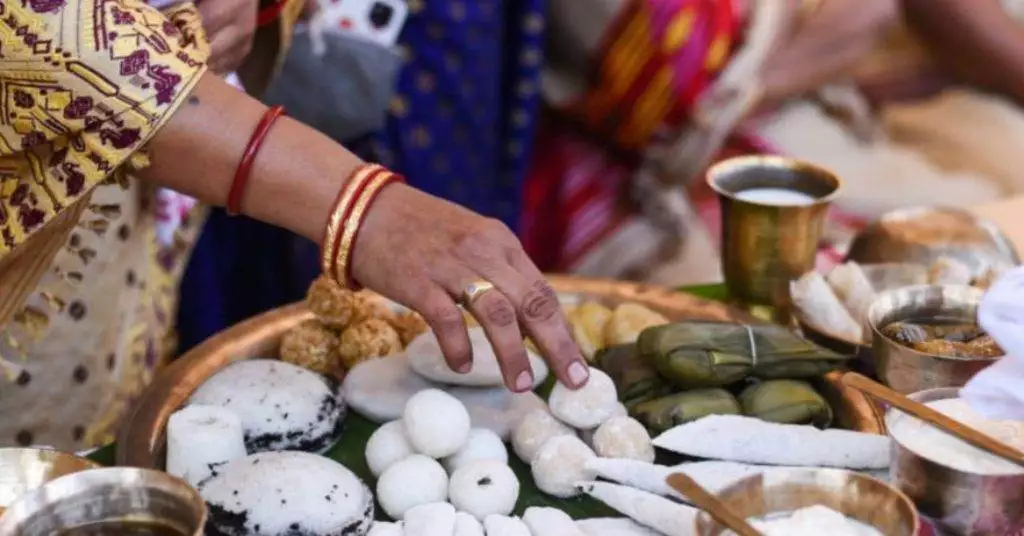
Bihu – overview
Bihu is the state festival of Assam and is celebrated to honour the significance of agriculture in rural Assamese life. The festival takes place three times a year, marking three distinct phases in the cultivation of paddy, which is the native crop of Assam. It is celebrated over several days and is characterized by great fun and enjoyment. Traditional folk songs and dances are the main attractions of this festival. The Bihu festival occurs during the pousha samkranti, chaitra samkranti, and aswina samkranti, representing three stages of agricultural life and the changing nature. Many myths and legends surround the origin of Bihu, and there is no definitive answer regarding when it originated. The tribal communities of Assam refer to the festival by various names, including Bihu, Bi-hau, Bisu, and Pisu. Regardless of its name, Bihu is fundamentally an expression of joy and merriment with the exception of Aswina sankranti which is a more solemn affair.
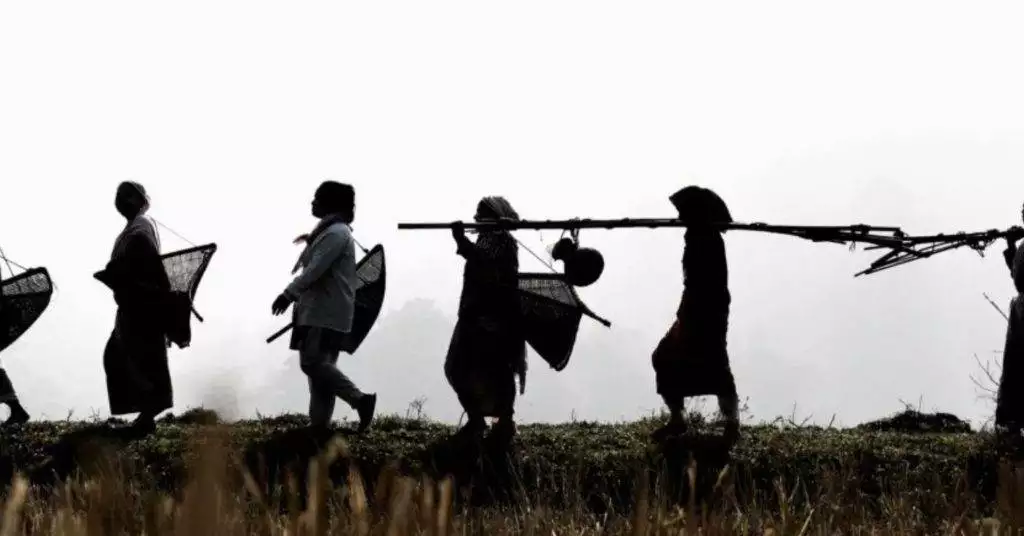
Bihu is the harvest festival of Assam and is the most important celebration for the Assamese people, enjoyed by everyone regardless of caste, creed, religion, faith, or belief. This festival has been closely tied to the agricultural communities of Assam for centuries. Bihu is observed in three parts, each corresponding to a specific stage in the paddy cultivation cycle throughout the agricultural year. The traditions surrounding Bihu have maintained their significance despite changing times. The past continues to resonate through various rites and rituals celebrated by agriculturalists during the autumnal Kati Bihu, the post-harvesting Magh Bihu during the winter solstice, and the springtime Bohag Bihu. The spring Bohag Bihu is celebrated in mid-April, following the sowing of the ‘Ahu’ paddy and before the transplantation of ‘Sali’ paddy. Kati Bihu is celebrated in mid-October, while Magh Bihu occurs in mid-January. It is a fact that successful harvests in primitive agrarian societies relied heavily on nature’s favour. Consequently, these early agricultural communities felt the need to appease nature for a bountiful yield. Several aspects of ancient Assam’s culture and beliefs contribute to the background of the Bihu festival. We can infer that the efforts and thoughts of these early people were deeply intertwined with their agricultural practices and seasonal rituals.The essence of the springtime Bihu songs and dances, which hold significant aesthetic value, is now showcased in publicly organized Bihu festivals. This new tradition of celebrating Bihu has gained immense importance in recent times.
*Sankranti (Sanskrit:Saṁkrānti) refers to the transmigration of the sun from one zodiac to another in Indian astronomy.
*Pausha Sankranti-Pausha or Poush Sankranti is a thanksgiving to the Sun God for a bountiful harvest. The festival begins with prayers and offerings, where newly harvested rice and date palm jaggery (nolen gur) are integral. These ingredients are not merely culinary staples, they symbolise the prosperity of the season.
*Chaitra Sankranti- Chaitra Sankranti,also known as Mesh Sankranti,it marks the beginning of the new year in the Hindu solar calendar
*Ashima Sankranti-Ashwin Sankranti is a festival that takes place in the month of Ashwin. On this day, the sun enters the sign of Virgo.
*Ahu paddy-Direct-seeded upland rice is an important system of rice culture occupying almost 22% of the total rice area in India. In Assam, this crop is locally known as ahu rice (Mar/Apr-Jun/July). Assam farmers prefer this crop because this period is characterized by low rainfall, clear skies, and low frequency of floods.
*Sali paddy-Sali paddy, also known as winter rice, is a type of rice that is grown during the winter months. It is grown in Assam, Meghalaya, and other regions.
Arrival of Bohaag
Spring time in Assam is a time of revelry and joyful riot, nature comes alive in the vibrant flora and fauna of the state,every inch of the earth covered in soft mossy greens, the air heavy with smells of mango blossoms and buzzing with bees that hum overhead.Somewhere atop a tree a coolee sings raucously announcing that spring has sprung.The crimson boughs of Modar and the pink purple cascading fall of the Kopou flower serenading just about every passerby, fields of flowering mustard greets your eyes as far as they can wander, the air is gently breezy with azure skies and promise of sunshine. This is a time to celebrate one of the most loved festivities of the state, the Rongali Bihu.The term ‘Rongali’ in Assamese means colourful and quite rightly so is this celebration. Not just in nature but extending to the moods of people irrespective of creeds that herald this time of the year with a pompous zeal.
The month of bohaag or Spring is a time to welcome the Assamese new year and with a new year comes renewed hopes and yearnings.Everyone is cheerful as they go about their daily chores but with a song and dance.
*Coolee – The Asian koel is a large cuckoo that is found in the Indian subcontinent, southeast China, and mainland southeast Asia.
*Modar-A beautiful flower that blooms only in mid March in Upper Assam.
*Kopou-A very rare orchid that blooms mostly in India’s North East, once a year during April. For the people of Assam this flower marks the festive season of Bihu, with girls putting up this flower in their buns or khupa(in Assamese), while performing the Bihu Dance
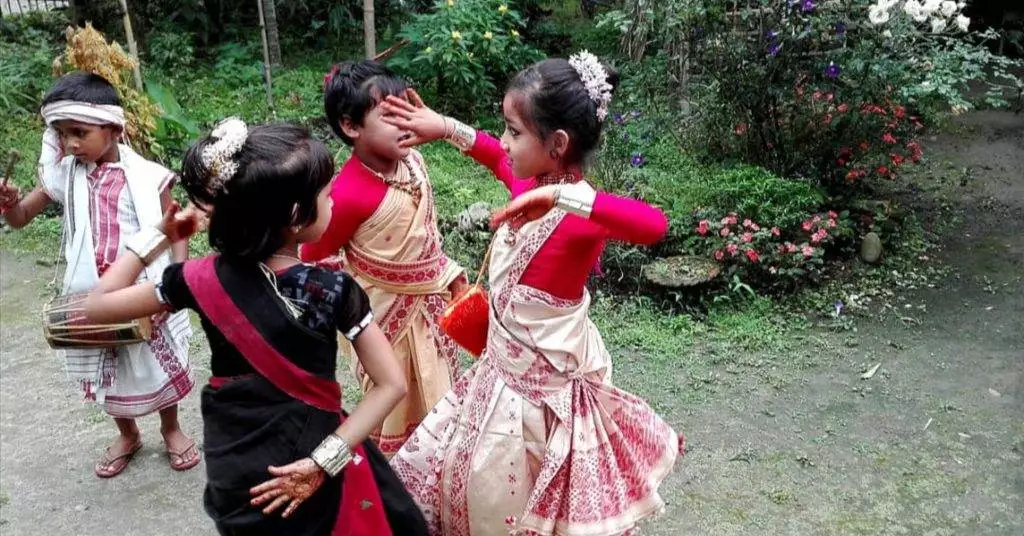
Lores of the season
It is believed that the term ‘Bihu’ originated from the language of the Dimasas, one of Assam’s many tribal communities. The words ‘bi’ (meaning: to ask) and ‘shu’ (meaning: peace and prosperity in the world) make for ‘Bihu’, which roughly translates to a celebration meant for the entire state. The Dimasas consider Brai Shibrai as their supreme god and traditionally offer him the first crop of the season, which is sown during this period.
Bohaag welcomes spring with a host of myths and legends. One of the most popular and fascinating of these is the legend of Bordoisila. Bordoisila is believed to be the daughter of Assam (the land) and is married to a groom from a distant land. She visits her maternal home once a year during spring. Legend has it that she is in such a hurry to meet her mother that she destroys anything in her path. It is a beautiful reference to the wild wind that eventually brings in the monsoon. Though different parts of the state have slightly varied versions of this tale, Bordoisila is believed to bring with her Bohaag, the spring season for the commencement of a carnival.
*Brai Shibrai –Brai Shibrai is the supreme god of the Dimasa people of Assam. The Bihu festival is celebrated three times a year to honor Brai Shibrai.
*Bordoisila –Bordoisila is an Assamese word that refers to a wild storm that occurs in the pre-monsoon season in Assam.

Quintessential Axomiya Jolpan
A cornerstone of the Bihu celebrations is jolpan, an elaborate breakfast spread served in every Assamese household to mark the beginning of the day’s festivities. This customary meal is both nourishing and symbolic, highlighting the importance of traditional foods. It typically features bora saul, a type of glutinous rice known for its chewy texture, served alongside fresh curd and jaggery. The combination of these ingredients is not only delicious but also a nod to the agricultural bounty of Assam. Breakfast during Bihu is a communal affair that includes not only the aforementioned items but also a warm cup of tea, making the meal a comforting and invigorating start to the festivities. This elaborate breakfast ritual fosters a sense of togetherness, reinforcing the bonds of family and community as everyone gathers around to enjoy the offerings of the season.
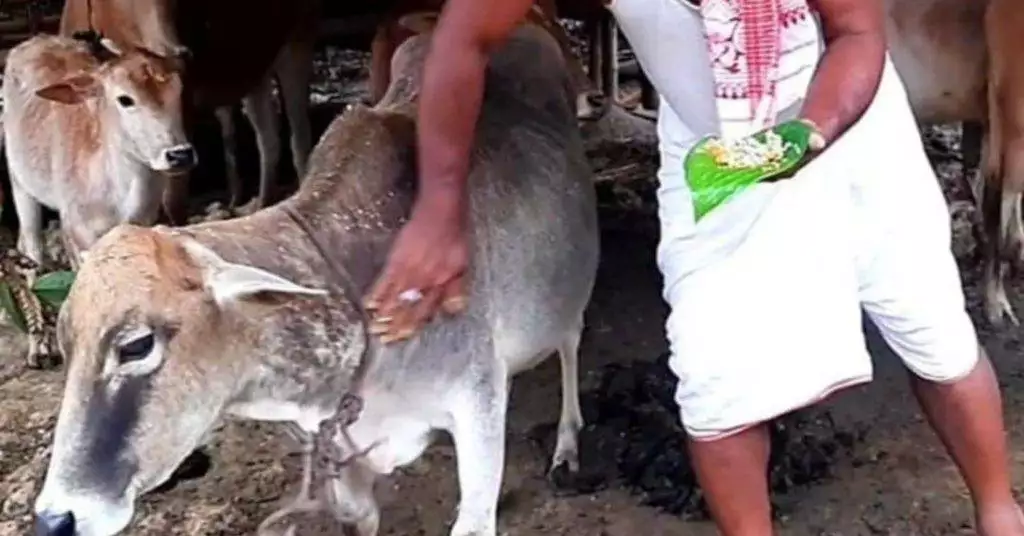
Honouring the animals
The first day of the Rongali Bihu festival is called Goru Bihu, which is Cow Bihu. This day focuses on the cattle in Assam, highlighting their importance in farming. Cattle provide essential support for agricultural work. The rituals for Goru Bihu start early in the morning. Families bathe their cows and apply a paste made of turmeric and other natural ingredients to keep them healthy. While doing this, they sing traditional Bihu geets that celebrate the health and productivity of the animals. This day honors cattle and emphasizes their important role in rural life
*Bihu geet – folk songs of Assam, sung during the Bihu festivities.
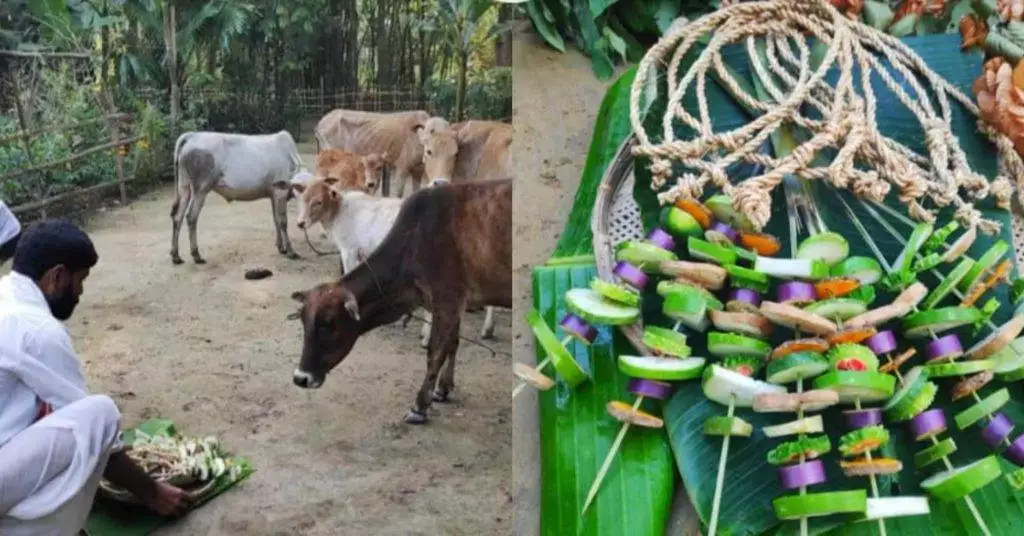
Songs as blessings
Husori is a style of singing performed in the courtyard of houses usually by village elders blessing the household for the coming year. This tradition goes back to the time of Ahom rulers; it was a performance limited only for the royalty but with time gained popularity with the commoners as well and now is ingrained in tradition.
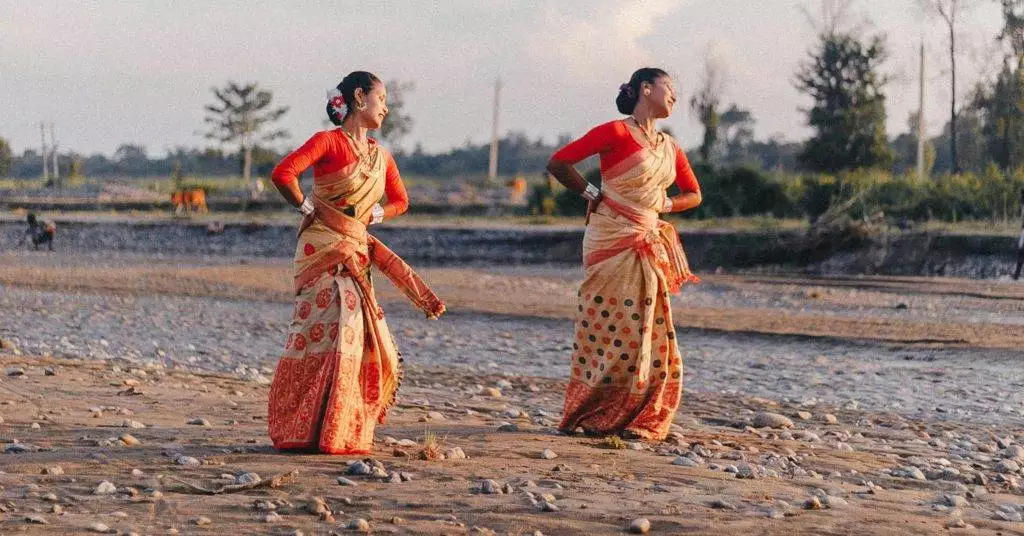
Dance as fertility ritual
Bihu dances are a vibrant and essential aspect of the festival, embodying the rich fertility rites of Assam. Farmers believe that the passionate and often provocative themes of the accompanying songs have the power to awaken the earth’s vitality, ultimately promising a bountiful harvest. The Bihu dance itself features lively and sensuous movements, with young women gracefully swaying their hips and gracefully extending their arms, all while celebrating their own fertility. This expressive dance is more than just a celebration; it can also be interpreted as a mating ritual, where young men and women come together in a joyful display of energy and connection, honoring the transformative power of the season.
Women dressed to the nines in golden hues of Muga silk Mekhela Sadors and red riha and apply jetuka (organic heena) to their hands, jetuka is seen as a symbol of beauty and festivity. Jetuka is a way of bringing colour to life as it’s an emblem of womanhood.The association of redness in their fingertips, palms, lips, and dress are meaningful and evocative. Red symbolizes ripeness and maturity and hence announces an inner vitality.By applying it and dancing Bihu Naas women attain their most mature and fertilized stage. They celebrate their sexuality through singing Bihu Geet. Romanticism and love encompass the environment. Unmarried young men and women move out in groups or form circles, dances and performs Mukoli Bihu.The word ‘mukoli’ means an open space. The Mukoli Bihu performance is performed in open space amidst nature.
*Jetuka-is an Assamese word that means “mehendi”. It also refers to the henna plant Lawsonia inermis, which is used for medicinal purposes and in the beauty industry.
*Bihu Naas – meaning Bihu dance is a traditional folk dance of Assam, India. It is a group dance performed by young men and women to celebrate the Bihu festival. The dance is known for its quick steps and rapid hand movements.
*Mekhela Sador -Mekhela Sador is a traditional two-piece dress worn by women of Assam. The word “mekhela” refers to the skirt, and “sador” refers to the drape.
*Riha is a traditional Assamese garment that is a long, narrow strip of fabric worn with a mekhela-sador ensemble. It is a type of unstitched corset that is part of the bridal trousseau for many Assamese brides.
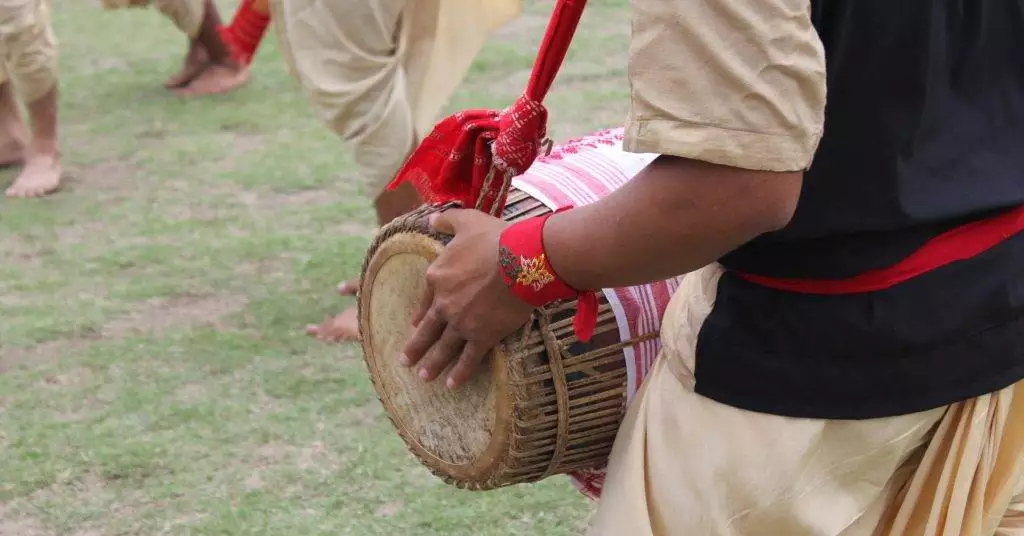
Unique traditions
While the joys of this month long spring festival is celebrated with much ardour all across the state the tiny island of Majuli, which happens to be the biggest river island in the world and also happens to be the seat of Assamese neo-Vaishnavite renaissance and the cultural capital of the region. Srimanta Sankardev, a religious and social reformer of the 16th century established Sattras (Vaishnavite monastery) for sharing religious discourses in Majuli. There is a tradition that dates back to centuries, it is called Buka Bihu or Buka khel, buka means mud in Assamese. Revelers playfully smear mud on each other,they regard mud as a symbol of peace and they believe that it has therapeutic properties and prevent them from getting any dermatological issues throughout the year. This is one of the prime attractions of the Bihu festivities here.
The Satras are not just monasteries, but centers of traditional performing arts and caretakers of ancient traditions.
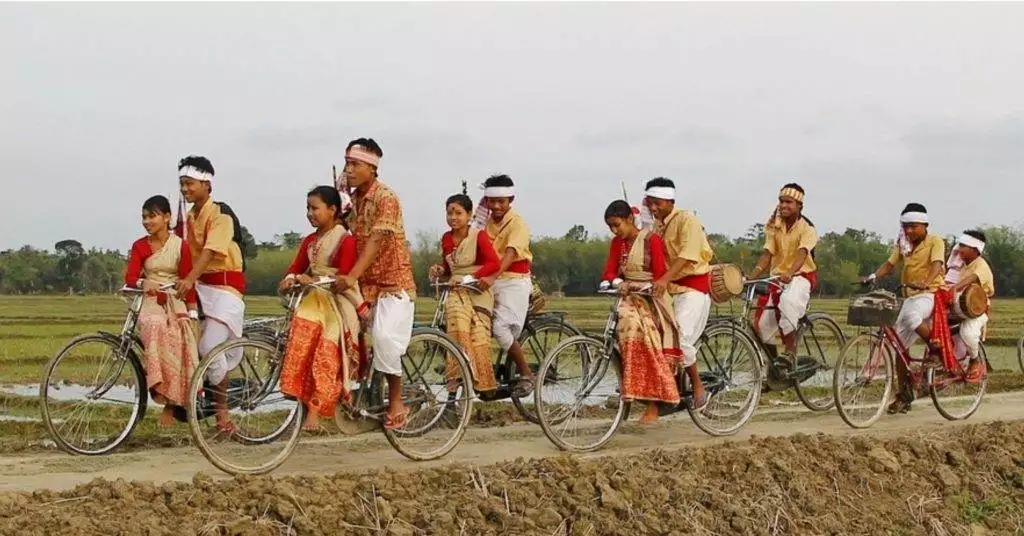
Present Bihu
Bihu has remarkably persevered through the ages, adapting to countless socio-cultural changes that have shaped the Assamese landscape. Its ability to transform and evolve in response to the shifting dynamics of society is a testament to its enduring relevance. Beginning as a celebration intimately tied to the agrarian lifestyle of Assam, Bihu has roots deep within the region’s rich agricultural traditions, honoring the cycles of planting and harvesting that define the lives of the farming communities.
As times changed, Bihu has embraced modernity, transitioning seamlessly into the digital realm. It now thrives not only in local villages but also through elaborate stage performances and virtual gatherings, allowing for a broader audience to engage with this vibrant festival. This evolution underscores Bihu’s adaptability and willingness to embrace new mediums while still honoring its historical and cultural foundations. The essence of Bihu—its songs, dances, and festive spirit—remains alive and dynamic, invigorating community bonds and nurturing a sense of identity.
As long as the Assamese people continue to celebrate their heritage and pass down these cherished traditions, Bihu will flourish, representing an unbreakable link to their past while confidently stepping into the future. This festival has become a living legacy, connecting generations and embodying the resilience and vibrant culture of the Assamese people, ensuring that the joy and significance of Bihu will endure for years to come.
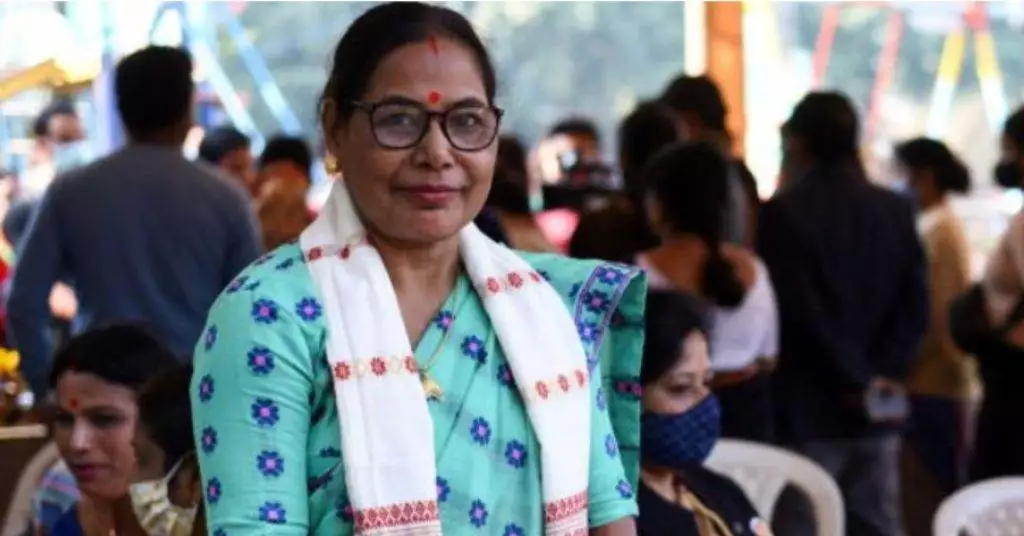


3 Responses
Beautifully written ❤️❤️
Thank you means much Pupps❤️
It is always very interesting to know the habits and customs of people around the world especially when well written and coming from good journalists.